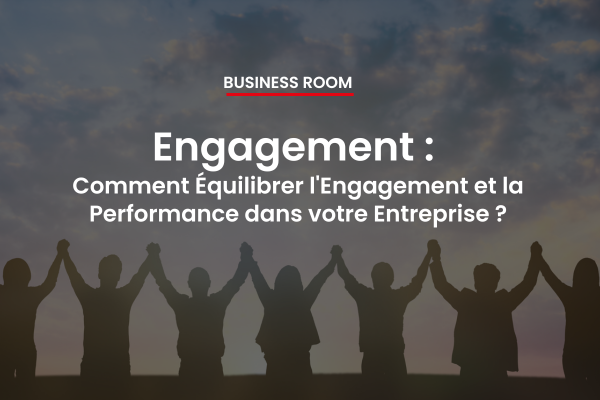Why Invest in Employee Engagement?
It’s no secret that an employee’s connection to their company impacts the way they approach their job and their customer relationships. What is striking are the studies showing that this level of engagement has a direct impact on profit growth.
A 2015 study[1] of 75 companies based on 3 continents (North America, Europe and Asia) showed the correlation between growth and engagement levels or…disengagement. Two companies even showed an average 132% increase in earnings per share by moving from a moderate level of employee engagement in the first year to the highest level of engagement the following year.
Does this mean that a motivated employee has a strong impact on a company's results?
Not quite, because there is a difference between commitment and motivation. Commitment is a feeling of usefulness, belonging and engagement towards an organisation. Motivation is the will and desire to act on one’s feelings. In the first case, it is about “all members of an organisation giving their best every day, committing to the goals and values of their organisation” and “being willing to make a special effort for their employer”, to go the famous “extra-mile”.
In 2006, a study compiled by Truss et al noted that: Women are generally more committed to their work than men, and older employees are generally more committed than younger ones.
So what options are there? How can you mobilise this performance factor for your organisation?
In 2006, a study compiled by Truss et al[2] noted that commitment comprises 3 dimensions:
- Emotional commitment, which is linked to being very emotionally involved in your work
- Cognitive commitment, which is linked to being very concentrated in your work
- Physical commitment, which means being prepared to go that extra mile for your employer.
In addition, self-determination theory (Deci & Ryan, 1985)[3] explains that the experience of employee commitment involves the satisfaction of basic psychological needs such as autonomy, competence and relationships.
Someone can be considered to be committed when they:
- Understand and actively support their organisation’s strategy
- Understand their role and the contribution they can make
- Genuinely want the organisation to be successful.
Happy employees ensure happy clients. Happy clients ensure happy shareholders – in that order.
Simon Sinek
So let us examine some practical aspects
How can we stimulate commitment within a team to increase individual and collective performance? Our approach is based on addressing the causes of a lack of engagement rather than just the symptoms of the lack of engagement. It intervenes on the different key dimensions that generate employee engagement. These dimensions are derived from a synthesis of various published conceptual foundations and concern:
- Autonomy: employees are able to take control of their work
- A sense of belonging: employees feel that they are supported and appreciated by their colleagues
- Competences: employees experience a sense of success and are able to evolve
- Strategy: employees are familiar with the corporate strategy and can identify with it.
- The organisation: employees work within a clearly defined framework of structures and processes
- Communication: employees have access to established bi-directional communication channels
How does this work?
We evaluate the perception of the team members based on 10 different dimensions using a barometer. The scores obtained tell the manager and the team where the problem lies and what needs to be worked on as a priority.
The most important part of the work is the root cause analysis. A bit like a doctor, once the diagnosis has been made, it is not just a matter of making the symptoms disappear on the surface, but getting to the root of the issue. In order to prevent certain situations from continuing, or to avoid the persistence of latent conflicts or deep-seated resentments, the “roots of the evil” must be extracted. To do this, we adapt the methodology used to each of the 10 dimensions. Once this process has been carried out, we can start to search for solutions.
And what does this lead to?
With one of our clients, we explored the missing “equity” dimension in their team, particularly with regard to a certain lack of clarity regarding the allocation of missions and the roles and responsibilities of each team member. Inevitably each team has a different interpretation of the lack of equity and the reasons for this will depend largely on each person’s experience and personality, as well as the corporate culture.
The root cause analysis focused on the equity issues linked to internal processes and managerial aspects. The subsequent discussions led to the formulation of various solutions:
- Process cartography
- RACI matrix
- Role and activity matrix
- Trusted person
- Job descriptions/and missions
- Coaching/Mentoring
- MBTI
- Managerial training
But it doesn’t stop there
Each item on the list of prioritised solutions is the subject of a project led by one of the volunteer “commitment supporters”, who is responsible for its implementation. A real team project is then set in motion and in the space of a few weeks, the initiatives should then become part of their priorities and become part of daily activities.
How can we be sure it will work?
This has not only been proven, it can even be monitored and measured.
Regular progress monitoring is carried out using agile methods to bring the various initiatives to fruition and integrate them into the existing rituals of the team’s life.
In addition, a second survey is sent out to assess the impact of the actions implemented and measure project progress. The indicators obtained are subsequently shared and discussed with the team.
And it still doesn’t stop there.
The aim is to gradually increase the team’s autonomy thanks to the sharing of acquired knowledge. Meetings with the “Engagement Supporters” are organised regularly to exchange on the way different solutions are implemented and to identify the most effective practices.
In this way, the methodology can be replicated internally and extended to other departments in order to increase the company’s overall commitment levels.
The closing session of the project allows for a retrospective and to select the next departments to carry out the process.
The ensuing company culture is the result of this commitment. It is the actions that make the company culture, not the words.
[1] bmg research, https://www.bmgresearch.co.uk/sector-expertise/employee-engagement/
[2] Truss, Katie, Soane, Emma , Edwards, Christine Yvonne L, Wisdom, Karen, Croll, Andrew and Burnett, Jamie (2006) Working life: employee attitudes and engagement 2006. . Chartered Institute of Personnel and Development, London, UK. ISBN 9781843981794
[3] https://selfdeterminationtheory.org/SDT/documents/2000_RyanDeci_SDT.pdf
WANT TO RECEIVE OUR LATEST THOUGHT LEADERSHIP CONTENT?
Related posts
 Have you Examined the Advantages of Working with Data Analytics yet?
Have you Examined the Advantages of Working with Data Analytics yet?
 Daring to Lead Positive Transformation: How can you implement and manage positive change with success?
Daring to Lead Positive Transformation: How can you implement and manage positive change with success?
 How to align engagement & performance in your company
How to align engagement & performance in your company
 Daring to Lead Positive Transformation: What are the Pillars and Benefits for your Business Success?
Daring to Lead Positive Transformation: What are the Pillars and Benefits for your Business Success?
 The 9 factors that should impact your approach to employee engagement
The 9 factors that should impact your approach to employee engagement




